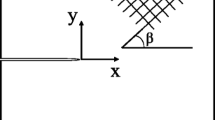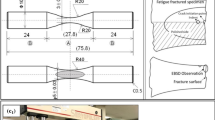Abstract
Fatigue crack propagation experiments performed on thin, single edge notched, polystyrene specimens show that during slow crack propagation, an intensive zone of crazing surrounds and precedes the propagating crack. The system of the crack and the craze zone constitute a crack layer (CL). The part of the CL ahead of the crack tip, where crazing accumulates prior to CL growth, is called the active zone. The width of the active zone is found to increase by almost an order of magnitude during slow CL propagation. Fractographic analysis reveals two types of discontinuous crack growth bands: multicycle bands and single cycle bands. The point of transition from multicycle to single cycle bands is established and used to extract crack speed from fracture surface markings. The experimental results demonstrate that fracture propagates by the translation, isotropic expansion and distortion of the active zone. Analysis of craze distribution within the active zone reveals that the craze density decreases away from the crack. A considerable difference in the critical energy release rates is observed in specimens fatigued under different loading levels. This is attributed to the difference in the density of crazes at the critical crack tip.
Résumé
Des expériences de propagation de fissure de fatigue effectuées sur des éprouvette de polystyrène minces à simple entaille latérale, montrent que, au cours d'une propagation lente d'une fissure, une zone importante de crazing précède ete entoure la fissure. Le système de la fissure et de la zone de crazing constitue une couche fissurée CF. La portion de la CF qui précède l'extrémité de la fissure est dénommée la zone active, où s'accumule le crazing avant croissance de la CF. On trouve que la largeur de la zone ative s'accroit d'à peu près un ordre de grandeur au cours de la propagation lente de la CF. L'analyse fractographique révèle deux types de bandes révélatrices de la croissance de la fissure: des bandes correspondant à plusieurs cycles et des bandes correspondant à un seul cycle. On établit le point de transition entre ces deux types de bandes, et on en fait usage pour déduire la vitesse de la fissure à partir des indications émanant de la surface de la rupture. Les résultats expérimentaux démontrent que la rupture se propage par translation, par expansion isotrope et par distorsion de la zone active. L'analyse de la distribution du crazing dans la zone active révèle que la densité du crazing décroit lorsqu'on s'éloigne de la fissure. Une différence considérable de vitesse critique de relaxation de l'énergie est observée dans des éprouvettes sollicitées en fatigue à des niveaux de sollicitation distincts. Ceci est attribué aux différences de densité de crazing à l'extrémité critique de la fissure.
Similar content being viewed by others
References
J.F. Knott, Fundamentals of Fracture Mechanics, Butterworths, London (1973).
D. Broek, Elementary Engineering Fracture Mechanics, Martinus Nijhoff, The Hague (1982)
H. Tada, P.C. Paris and G.P. Irwin, The Stress Analysis of Cracks Handbook, Del Research Corporation, Hellertown, Pennsylvania (1975).
M. Bevis and D. Hull, Journal of Materials Science 5 (1970) 983–987.
A. Chudnovsky, Crack Layer Theory, NASA Report CR-174634, March (1984).
A. Chudnovsky, Crack Layer Theory, Journal of Applied Mechanics, to appear.
D.S. Dugdale, Journal of the Mechanics and Physics of Solids, 8 (1960) 100–104.
G.I. Barenblatt, in Advances in Applied Mechanics 1962, Vol. 67, Academic Press, New York (1962) 55–125.
G.M. Jacoby in Electron Microscopy, ASTM STP 453 (1969) 147–172.
N.J. Mills and N. Walker, Journal of Materials Science 15 (1980) 1832–1840.
M. Kitagawa, Journal of Materials Science 17 (1982) 2514–2524.
K. Sehanobish, E. Baer, A. Chudnovsky and A. Moet, Journal of Materials Science 20 (1985) 1934–1939.
A. Moet, I. Palley and E. Baer, ACS Organic Coating and Plastics Chemistry 41 (1969) 424–429.
N. Haddaoui, A. Chudnovsky and A. Moet, ACS Organic Coating and Applied Polymer Science Proceedings 49 (1983) 117–123.
A. Chudnovsky, A. Moet, R.J. Bankart and M.T. Takemori, Journal of Applied Physics 54 (1983) 5562–5567.
M.P. Wnuk, International Journal of Fracture 10 (1974) 223–226.
J.G. Williams, Journal of Materials Science 12 (1977) 2525–2533.
J.P. Elink, J.C. Baumens and G. Howes, International Journal of Fracture Mechanics 7 (1971) 277–287.
H.R. Brown and I.M. Ward, Polymer 14 (1973) 69–473.
L. Lonzol, M.G. Schinker and W. Doll, in International Conference in Fatigue in Polymers, The Plastics and Rubber Institute, London (1983) 4.1–4.10.
J.S. Broderick, R.A. Duckett and I.M. Ward, in International Conference in Fatigue in Polymers, The Plastic and Rubber Insititue, London (1983) 5.1–5.9.
M. Skibo, R.W. Hertzberg and J.A. Manson, Journal of Materials Science 11 (1976) 479–490.
A. Moet, unpublished.
C.J. Beevers, R.J. Cooke, J.F. Knott and R.O. Ritchie, Metal Science Journal 9 (1975) 119–126.
V. Hibino, S. Skaguchi and V. Tajima, Journal of Materials Science 2 (1983) 388–392.
S.C. Kinz and P.W.R. Beaumont, ASTM STP 569 (1975) 71–91.
P.X. Nguyen, Master's thesis, Case Western Reserve University, Cleveland Ohio (1984).
J. Botsis, Ph.D. dissertation, Case Western Reserve University Cleveland Ohio (1984).
Author information
Authors and Affiliations
Rights and permissions
About this article
Cite this article
Botsis, J., Chudnovsky, A. & Moet, A. Fatigue crack layer propagation in polystyrene—Part I experimental observations. Int J Fract 33, 263–276 (1987). https://doi.org/10.1007/BF00044415
Received:
Accepted:
Issue Date:
DOI: https://doi.org/10.1007/BF00044415




